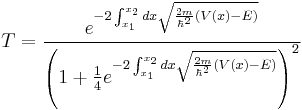Transmission coefficient
The transmission coefficient is used in physics and electrical engineering when wave propagation in a medium containing discontinuities is considered. A transmission coefficient describes the amplitude, intensity, or total power of a transmitted wave relative to an incident wave.
Different fields have different definitions for the term.
Contents |
Optics
In optics, transmission is the property of a substance to permit the passage of light, with some or none of the incident light being absorbed in the process. If some light is absorbed by the substance, then the transmitted light will be a combination of the wavelengths of the light that was transmitted and not absorbed. For example, a blue light filter appears blue because it absorbs red and green wavelengths. If white light is shone through the filter, the light transmitted also appears blue because of the absorption of the red and green wavelengths.
The transmission coefficient is a measure of how much of an electromagnetic wave (light) passes through a surface or an optical element. Transmission coefficients can be calculated for either the amplitude or the intensity of the wave. Either is calculated by taking the ratio of the value after the surface or element to the value before.
Quantum mechanics
In non-relativistic quantum mechanics, the transmission coefficient and related reflection coefficient are used to describe the behavior of waves incident on a barrier. The transmission coefficient represents the probability flux of the transmitted wave relative to that of the incident wave. It is often used to describe the probability of a particle tunneling through a barrier.
The transmission coefficient is defined in terms of the incident and transmitted probability current density j according to:
where Jinc is the probability current in the wave incident upon the barrier with normal unit vector  and Jtrans is the probability current in the wave moving away from the barrier on the other side.
and Jtrans is the probability current in the wave moving away from the barrier on the other side.
The reflection coefficient R is defined analogously, as R=|jreflected|/|jincident|. Conservation of probability implies that T+R=1, which in one dimension reduces to the fact that the sum of the transmitted and reflected currents is equal in magnitude to the incident current.
For sample calculations, see finite potential barrier or square potential.
WKB approximation
Using the WKB approximation, one can obtain a tunnelling coefficient that looks like
Where  are the two classical turning points for the potential barrier. If we take the classical limit of all other physical parameters much larger than Planck's constant, abbreviated as
are the two classical turning points for the potential barrier. If we take the classical limit of all other physical parameters much larger than Planck's constant, abbreviated as  , we see that the transmission coefficient correctly goes to zero. This classical limit would have failed in the situation of a square potential.
, we see that the transmission coefficient correctly goes to zero. This classical limit would have failed in the situation of a square potential.
If the transmission coefficient is much less than 1, it can be approximated with the following formula:
where  is the length of the barrier potential.
is the length of the barrier potential.
Telecommunication
The transmission coefficient is the ratio of the amplitude of the complex transmitted wave to that of the incident wave at a discontinuity in the transmission line.
The probability that a portion of a communications system, such as a line, circuit, channel or trunk, will meet specified performance criteria is also sometimes called the "transmission coefficient" of that portion of the system. The value of the transmission coefficient is inversely related to the quality of the line, circuit, channel or trunk.
Chemistry
The transmission coefficient is a state of unity for monomolecular reactions. It appears in the Eyring equation.
References
- Telecommunication: Federal Standard 1037C in support of MIL-STD-188
- Griffiths, David J. (2004). Introduction to Quantum Mechanics (2nd ed.). Prentice Hall. ISBN 0131118927.


